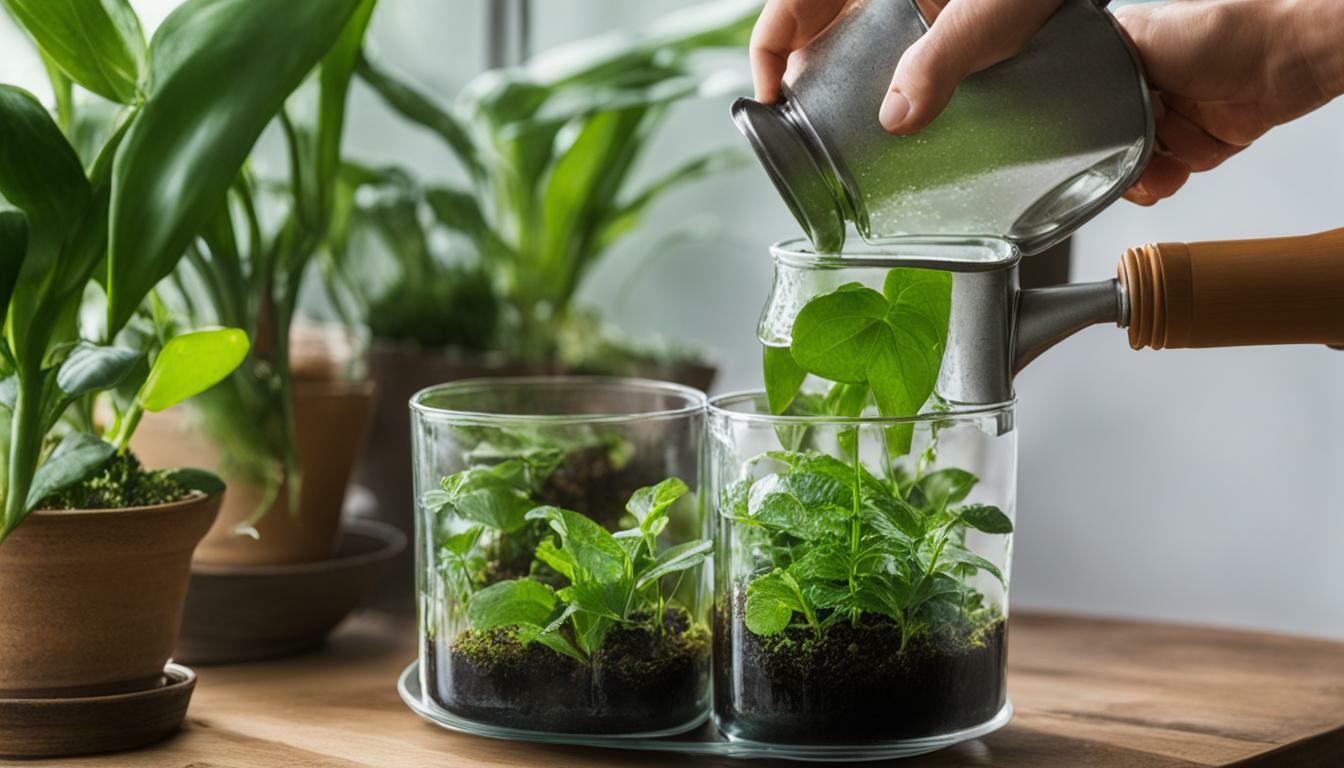Proper watering is crucial for maintaining the health and vibrancy of your terrarium plants. Terrariums are self-contained ecosystems that require attention to watering in order for the plants to thrive. Avoiding common watering mistakes is essential for the long-term success of your terrarium.
Key Takeaways:
- Underwatering can lead to dehydration and stunted growth in terrarium plants. Monitor humidity levels and check for signs of dryness to prevent this issue.
- Overwatering is a bigger risk and can cause root rot and fungal growth. Add water in small increments and avoid saturating the substrate to prevent excessive moisture.
- Provide the right amount of light for your terrarium plants. Avoid scorching them with direct sunlight or depriving them of light, as both can negatively impact their health.
- Manage mold growth in your terrarium by improving airflow, wiping surfaces with hydrogen peroxide or chamomile tea, and using springtails as a natural preventative measure.
- Remove rotting plants promptly to prevent the spread of mold and maintain the overall balance within the terrarium.
By avoiding these common watering mistakes and following proper care guidelines, you can ensure vibrant growth and long-lasting health for your terrarium plants.
Underwatering the Terrarium: Signs and Solutions
Neglecting to provide adequate water to your terrarium can have detrimental effects on the overall health of your plants. Underwatering is a common mistake that can lead to stunted growth, wilted leaves, and even plant death. To prevent under-watering in your terrarium, it’s important to monitor the humidity levels and look for signs of dryness in the soil.
One effective way to check the humidity is by observing the condensation on the sides of the terrarium. If there is no condensation or it disappears quickly, it indicates low humidity. Additionally, feel the soil with your fingers – if it feels dry about an inch below the surface, it’s a clear sign that your terrarium needs water.
To address under-watering, you should mist the terrarium with water using a spray bottle or water the plants directly at the soil level. Be careful not to overwater, as this can lead to other issues such as mold or root rot. It’s always better to start with less water and gradually increase if needed, depending on the specific requirements of your plants.
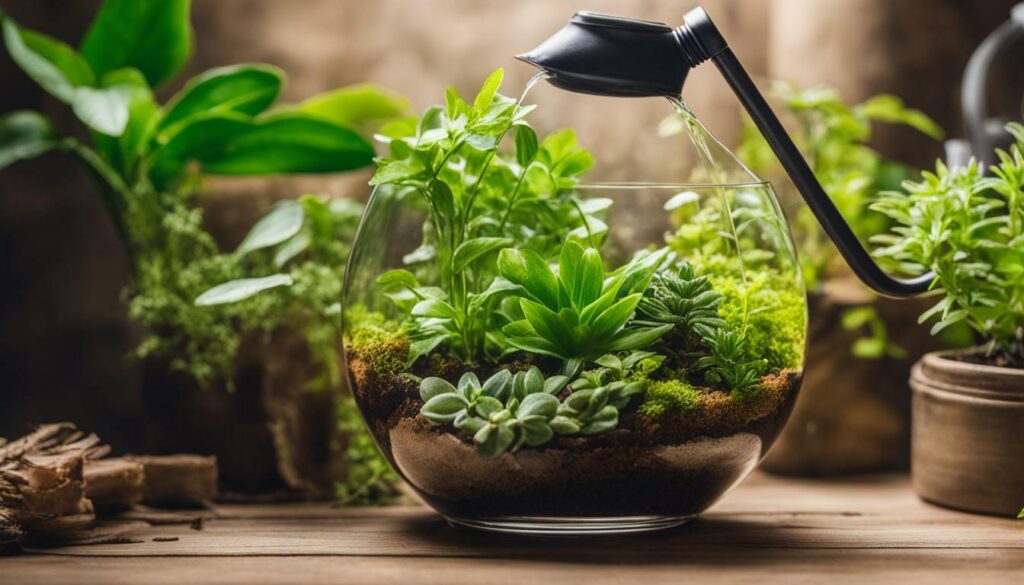
Signs of Underwatering
| Signs | Solutions |
|---|---|
| Wilting leaves | Mist the terrarium or water at the soil level |
| Dry soil about an inch below the surface | Increase the frequency of watering |
| Lack of condensation on terrarium walls | Improve humidity levels or mist the terrarium more frequently |
Overwatering Woes: Avoiding Excessive Moisture in Your Terrarium
Overwatering is a common mistake that can lead to serious problems for your terrarium plants. While it may seem like more water equals healthier plants, the reality is quite different. Excessive moisture can result in root rot, mold growth, and even the death of your beloved greenery. To keep your terrarium thriving, it’s essential to understand the signs of overwatering and take preventive measures.
One telltale sign of overwatering is waterlogged soil. If the soil feels constantly wet or soggy to the touch, it’s a clear indication that your terrarium is getting too much water. Additionally, yellowing or browning leaves can also be a sign of excessive moisture. These symptoms occur because the roots are suffocating and unable to absorb oxygen properly.
To prevent overwatering in your terrarium, it’s crucial to water in small increments. Instead of drenching the soil, gradually add water and allow it to be absorbed before adding more. It’s also essential to choose the right substrate for your terrarium. Using a well-draining substrate, such as a mixture of peat moss and perlite, helps excess water to flow away from the roots, reducing the risk of overwatering.
Preventing Overwatering in Terrariums
- Monitor the humidity levels: Keeping track of the humidity in your terrarium can help you gauge when it’s time to water.
- Check the soil moisture: Before watering, use a moisture meter or stick your finger about an inch into the soil to check for dryness.
- Provide proper ventilation: Good air circulation within the terrarium helps to prevent excess moisture buildup and reduces the risk of mold growth.
- Consider the plant’s water needs: Different plants have varying water requirements. Be mindful of the specific needs of your terrarium plants and adjust your watering frequency accordingly.
By understanding the signs of overwatering and implementing preventive measures, you can ensure a healthy and thriving terrarium ecosystem. Remember, finding the right balance between hydration and moisture control is key to the long-term success of your terrarium plants.
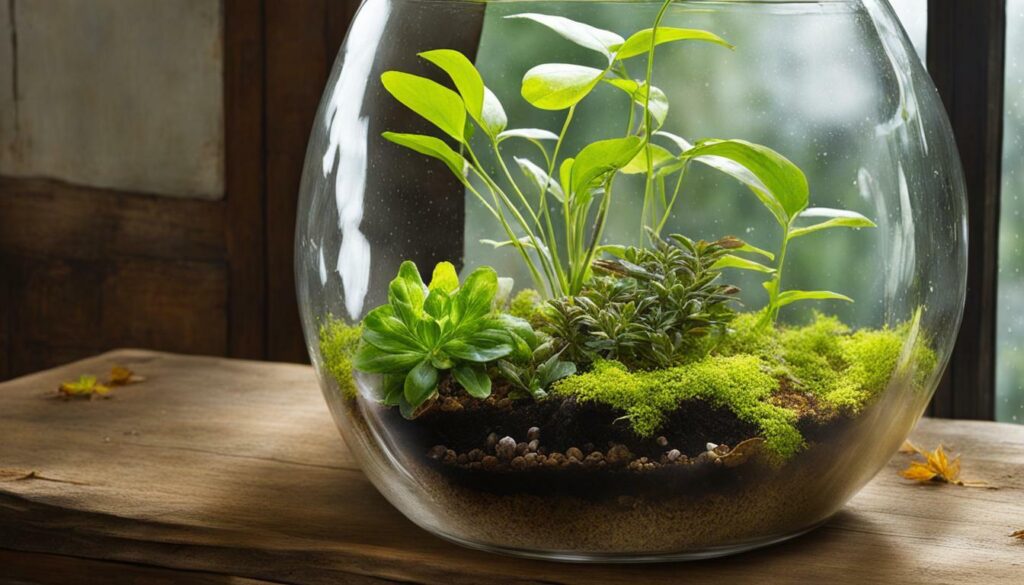
Achieving the perfect balance of hydration for your terrarium is essential for the health and longevity of your plants. Proper watering techniques can make all the difference in maintaining a thriving ecosystem. Here are some valuable tips to help you water your terrarium the right way:
- Monitor moisture levels: Different types of terrariums require different watering frequencies. Check the moisture levels in the soil regularly to determine when it’s time to water. Avoid overwatering by ensuring that the soil is slightly damp but not saturated.
- Water in small increments: Rather than drenching the entire terrarium at once, add water in small increments. This allows the plants to absorb moisture gradually and prevents waterlogged roots.
- Consider plant needs: Each plant species has its own specific watering requirements. Research the plants in your terrarium to understand their individual needs. Some plants prefer more moisture, while others thrive in drier conditions.
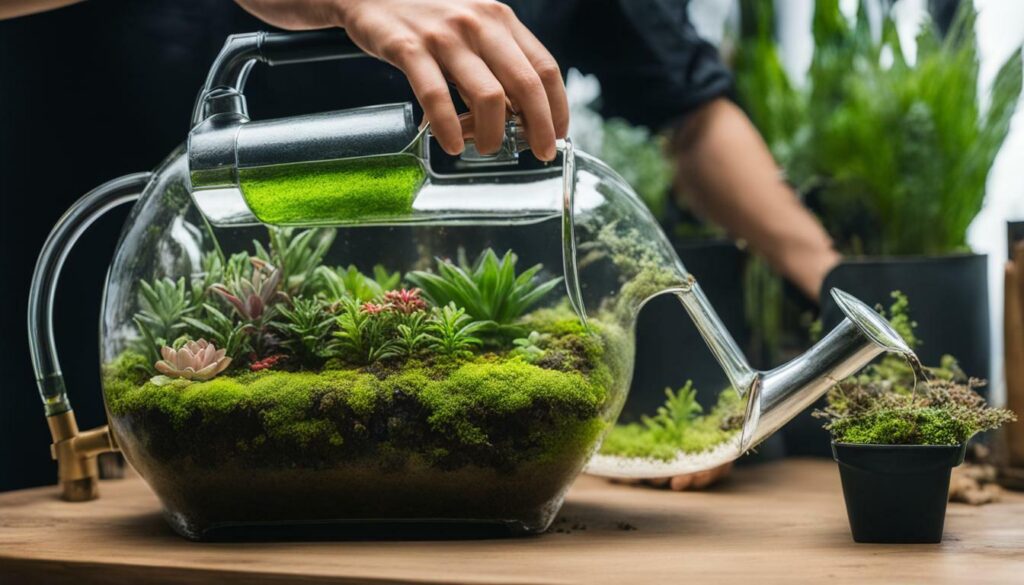
Remember to adapt your watering routine based on the time of year and environmental conditions. During hot summer months, you may need to water more frequently, while in cooler seasons, you may need to reduce watering. Striking the right balance will contribute to the overall health and vitality of your terrarium plants.
Expert Tip:
“When watering your terrarium, always use room-temperature water. Cold water can shock the plants, while hot water can damage the delicate roots. Aim for lukewarm water to ensure optimal plant health.”
| Watering Mistake | Consequences | Solution |
|---|---|---|
| Overwatering | Root rot, mold growth | Add water in small increments and ensure proper drainage |
| Underwatering | Wilting, stunted growth | Monitor moisture levels and provide adequate hydration |
| Inconsistent watering | Uneven growth, stress on plants | Establish a regular watering schedule and stick to it |
By following these proper watering techniques, you can create a healthy and vibrant terrarium that brings beauty and nature into your home.
Shedding Light on Terrarium Lighting: Finding the Sweet Spot
Light plays a crucial role in the growth and development of your terrarium plants, and finding the right amount is key to their success. Too little light can hinder photosynthesis, leading to weak and stunted growth, while too much light can scorch the leaves and cause damage. So, how do you strike the perfect balance in your terrarium?
Start by considering the light requirements of the plants in your terrarium. Some plants thrive in bright, indirect light, while others prefer lower light conditions. Research the specific needs of your plant species to ensure optimal growth.
Next, observe the light levels in the location where your terrarium is placed. Is it near a window that receives direct sunlight? Is it in a shaded area? Adjust the position of your terrarium accordingly to provide the appropriate amount of light. You may need to experiment with different locations until you find the sweet spot.
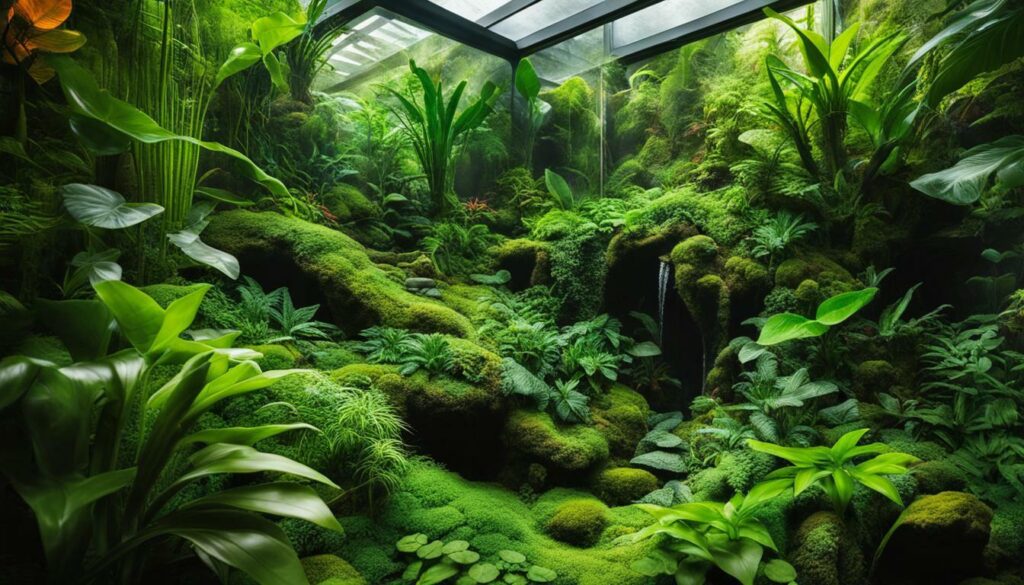
In addition to natural light, you can also supplement with artificial lighting, especially if your terrarium is located in a dimly lit area. LED grow lights are a popular choice as they provide the right spectrum of light for plant growth. Place the lights above your terrarium, making sure they are not too close to avoid burning the plants.
Proper Watering Techniques for Terrariums
When it comes to watering your terrarium, the frequency will depend on various factors such as the type of plants, the size of the terrarium, and the ambient humidity. As a general rule, it’s better to underwater than overwater. Most terrarium plants prefer slightly moist soil rather than waterlogged conditions.
To determine if your terrarium needs watering, check the soil moisture level. Stick your finger about an inch into the soil; if it feels dry, it’s time to water. Use a watering can with a narrow spout to avoid oversaturating the soil. Be careful not to pour water directly onto the plants as it can trap moisture and promote fungal growth.
Remember, each terrarium is unique, and you’ll need to observe and adjust your watering routine accordingly. By finding the right balance of light and water, you can create a thriving terrarium filled with healthy and happy plants.
Managing Mold in Terrariums: Quick Tips for Cleaner Environments
Mold can be a nuisance in terrariums, but with the right precautions, you can effectively control its presence. Proper terrarium maintenance is key to preventing mold growth and ensuring a clean and healthy environment for your plants. Here are some quick tips to help you manage mold in your terrarium:
- Improve airflow: Adequate air circulation is essential for reducing humidity levels and preventing mold. Open the terrarium lid occasionally to allow fresh air to circulate, or consider using a small fan to improve ventilation.
- Wipe with hydrogen peroxide or chamomile tea: If you notice mold on the terrarium glass or other non-living surfaces, you can wipe it away with a solution of hydrogen peroxide or chamomile tea. Both options have antimicrobial properties that can help control mold growth.
- Utilize springtails: Springtails are tiny arthropods that feed on organic matter, including mold. Adding springtails to your terrarium can help control mold and other unwanted pests. These beneficial creatures can be purchased online or at a local pet store specializing in terrarium supplies.
- Maintain proper moisture levels: Excess moisture is a major contributor to mold growth in terrariums. Avoid overwatering your plants and ensure that the substrate is not overly saturated. Use a spray bottle to add small amounts of water as needed, focusing on the root area and avoiding direct contact with the leaves.
By following these simple tips, you can keep mold at bay and maintain a clean and healthy terrarium environment for your beloved plants.
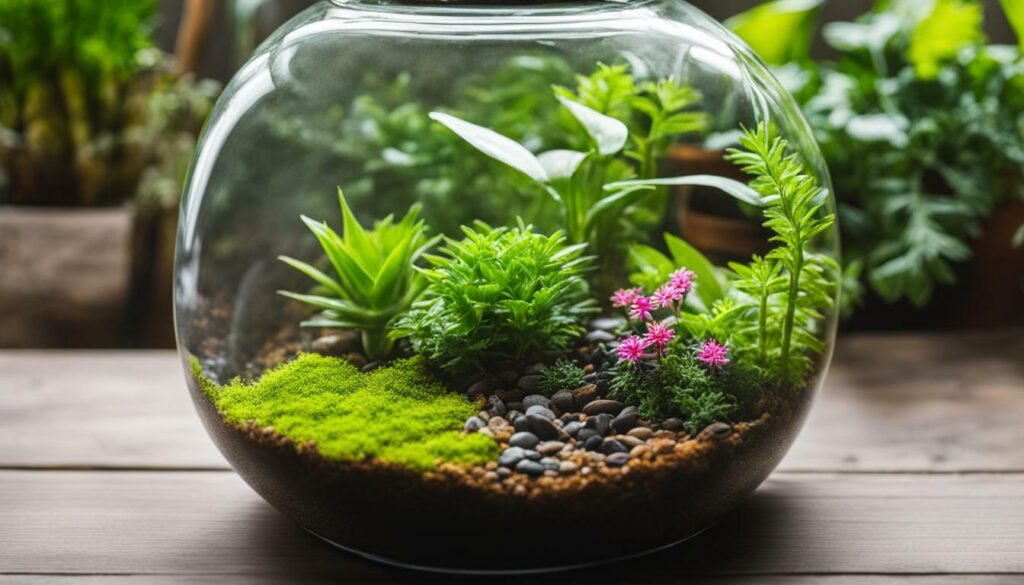
| Type of Mold | Description | Prevention & Treatment |
|---|---|---|
| White mold (Botrytis) | A fluffy, powdery white mold that typically appears on decaying plant material or in humid conditions. | – Maintain proper airflow and ventilation – Remove decaying plants promptly – Wipe affected areas with hydrogen peroxide or chamomile tea |
| Green mold (Penicillium) | A fuzzy green mold that thrives in damp and humid environments, commonly found on decaying fruit or vegetables. | – Control moisture levels to prevent excess humidity – Dispose of rotting organic matter – Clean affected surfaces with hydrogen peroxide or chamomile tea |
| Black mold (Stachybotrys) | A dark, slimy mold that typically grows on cellulose-rich materials, such as wood or paper, in damp conditions. | – Monitor moisture levels and address any sources of water leakage – Remove affected materials, if necessary, and improve ventilation – Consult with a professional for severe cases of black mold |
Don’t Let It Rot: Removing Decaying Plants in a Timely Manner
To maintain a healthy terrarium environment, it is crucial to remove any rotting plants as soon as possible. Plant decay can quickly lead to mold growth and an imbalanced ecosystem, affecting the overall health of the plants. Timely removal of decaying vegetation is essential for preserving the vitality and longevity of your terrarium.
When inspecting your terrarium, keep an eye out for any plants that show signs of rotting. Look for wilted leaves, discoloration, or a foul odor. These are clear indicators that a plant is decaying and needs to be removed promptly. Use a pair of clean and sterilized scissors or gardening shears to carefully trim away the affected parts.
Once you have removed the decaying plants, take the opportunity to assess the overall condition of your terrarium. Check the humidity levels, substrate moisture, and the growth of other plants. Adjust the watering and care routine if necessary to prevent further issues.
Remember, prevention is key to maintaining a thriving terrarium. Regularly monitor the health of your plants and take preemptive measures to avoid rotting. Ensure good airflow within the terrarium to prevent stagnant moisture. Additionally, be mindful of the water and light requirements of each plant species in your terrarium, as improper care can contribute to plant decay.
| Key Takeaways: |
|---|
| Removing rotting plants promptly is crucial for maintaining a healthy terrarium environment. |
| Look for signs of decay such as wilted leaves, discoloration, or a foul odor. |
| Use clean and sterilized scissors or shears to trim away decaying parts. |
| Regularly assess the overall condition of your terrarium and adjust care routines as needed. |
| Prevent plant decay by ensuring good airflow and providing the proper water and light requirements. |
By keeping a watchful eye on the health of your terrarium plants and taking swift action when decay occurs, you can create a vibrant and thriving miniature ecosystem that brings nature into your home.
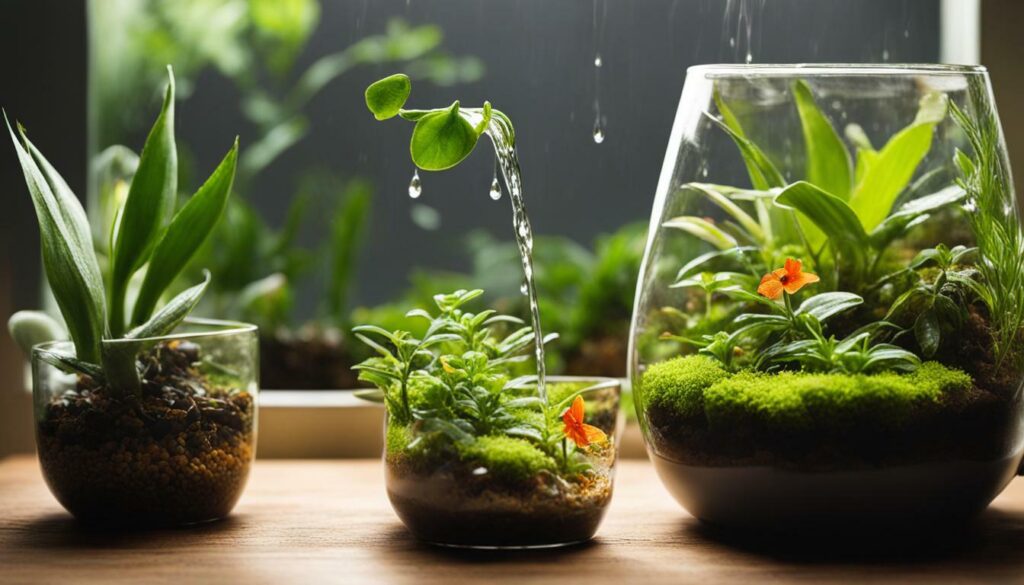
As your terrarium plants grow, it is essential to keep them in check to maintain a thriving and aesthetically pleasing miniature ecosystem. Overgrown plants can block light from reaching other plants, hinder airflow, and disrupt the balance of your terrarium. Fortunately, with proper trimming techniques, you can tame the jungle and ensure the health and beauty of your terrarium.
When it comes to trimming overgrown plants in a terrarium, precision is key. Use clean, sharp pruning shears or scissors to make clean cuts, avoiding any tearing or damage to the plant. It’s important to prune selectively, removing only the necessary growth to maintain the desired shape and size.
Before you start trimming, take a step back and assess the overall appearance of your terrarium. Identify which plants are growing too large or obstructing others. Trim back any branches or leaves that are overcrowding the space or preventing light from reaching neighboring plants. This will help maintain a balanced and harmonious terrarium environment.
| Trimming Tips: |
|---|
| 1. Start with small cuts: Trim gradually, rather than removing large sections at once. This allows the plant to adjust and reduces the risk of shock. |
| 2. Remove dead or damaged growth: Trim away any yellowed or brown leaves, as they can attract pests and detract from the overall appearance of your terrarium. |
| 3. Maintain proper spacing: Ensure that each plant has enough room to grow without overcrowding its neighbors. |
| 4. Consider the plant’s growth habit: Different plant species have varying growth habits, so research the specific needs of each plant before trimming. Some plants may benefit from regular pruning, while others require minimal intervention. |
Remember, the goal of trimming is not only to control the size of your plants but also to enhance the overall visual appeal of your terrarium. Pruning creates a sense of balance and allows the other elements, such as rocks or decorative items, to shine. So take your time, trim with care, and enjoy the rewarding process of taming your terrarium jungle.
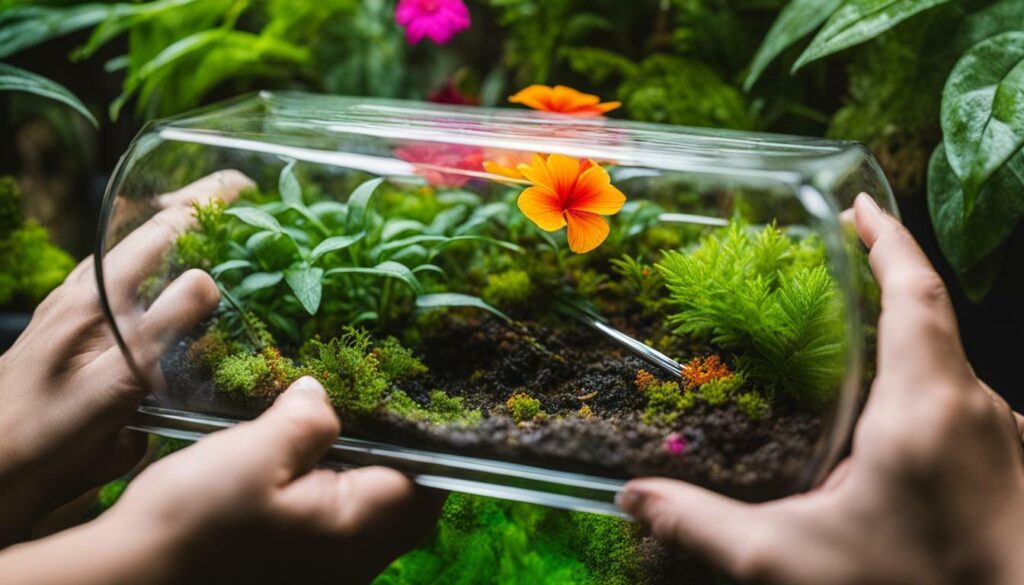
A clean glass enclosure is essential for showcasing the beauty of your terrarium plants and ensuring their well-being. Not only does it provide an uninterrupted view of your miniature ecosystem, but it also allows maximum light penetration, which is vital for plant growth. In this section, we will explore some practical tips and techniques to help you keep your terrarium glass sparkling clean.
To begin, gather the necessary cleaning supplies. Opt for non-toxic solutions to avoid any harmful residue that may affect your plants. A mixture of mild dish soap and warm water is an effective and safe choice. Alternatively, you can create a natural cleaning solution using equal parts white vinegar and water. Both options will help cut through dirt and grime without posing a risk to your plants.
When cleaning the glass, use a soft cloth or sponge to gently wipe away any debris. Avoid using abrasive materials that could scratch the glass surface. Start at the top and work your way down, ensuring that you clean both the inner and outer surfaces. If you encounter stubborn stains or mineral deposits, you can use a sponge soaked in vinegar-water solution to remove them.
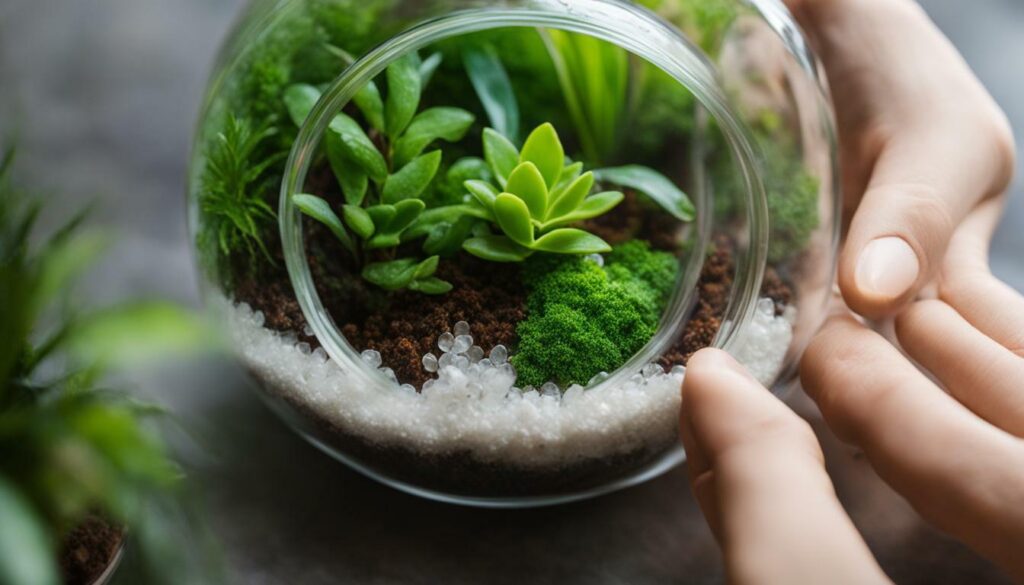
Finally, be mindful of the frequency of glass cleaning. While it’s important to maintain a clear view, excessive cleaning may disrupt the balance of your terrarium. Aim to clean the glass once every few weeks or as needed, depending on the level of dirt and dust accumulation. Regularly observe your terrarium’s glass for any signs of obstruction or smudges that may hinder optimal plant growth.
By following these tips, you can ensure that your terrarium remains a captivating and healthy environment for your plants. A clean glass enclosure not only enhances the visual appeal of your terrarium but also promotes the overall well-being of your mini-ecosystem.
What are some common watering mistakes to avoid for beginners in terrarium care?
When caring for a terrarium, it’s important to remember some essential terrarium care tips. Overwatering is a common mistake for beginners. Ensure proper drainage to prevent waterlogged soil. Also, be mindful of the watering schedule and avoid under or overwatering to maintain a healthy terrarium ecosystem.
Conclusion
By avoiding common watering mistakes and following proper care techniques, you can ensure your terrarium plants thrive in their tiny green oasis.
Terrariums are low-maintenance and self-contained ecosystems that offer a beautiful way to showcase houseplants. However, to keep your terrarium plants healthy, it’s essential to understand and avoid common watering mistakes.
One common mistake is underwatering, which can have detrimental effects on your terrarium. To prevent this, regularly monitor the humidity levels and check for signs of dryness in the soil. Proper watering will help maintain the right balance of moisture for your plants to thrive.
Overwatering is another significant risk that can lead to root rot and other plant health issues. To avoid excessive moisture in your terrarium, add water in small increments and ensure that the substrate is not saturated. This will help prevent waterlogging and maintain a healthy environment for your plants.
Providing the right amount of light is crucial for the growth and development of your terrarium plants. Avoid depriving them of light or subjecting them to intense, direct sunlight that can scorch the foliage. Finding the optimal balance will ensure your plants receive the light they need for photosynthesis and avoid any light-related issues.
Mold can be a common problem in terrariums due to the high humidity levels. However, there are ways to manage and prevent it. Improving airflow by opening the terrarium occasionally, wiping surfaces with hydrogen peroxide or chamomile tea, and introducing springtails as natural predators can help keep mold growth at bay.
In addition, it’s important to promptly remove any rotting plants from your terrarium to maintain a healthy balance and prevent the spread of mold. Regularly assess the condition of your plants and remove any decaying foliage to preserve the overall well-being of the ecosystem.
If your plants become overgrown, trimming them back is necessary to maintain their health and prevent them from blocking light to other plants. Regular pruning will help ensure a visually appealing terrarium and create space for new growth.
Finally, keeping the terrarium glass clean is essential for the health and aesthetics of your plants. Regularly wipe away dust and debris from the glass to prevent obstruction and allow optimal light transmission for photosynthesis.
By following these guidelines and providing proper care for your terrarium plants, you can enjoy a vibrant and thriving miniature garden that adds beauty and serenity to your space.
FAQ
What are some common watering mistakes to avoid in terrarium care?
Some common watering mistakes to avoid in terrarium care include underwatering and overwatering. It’s important to find the right balance to ensure healthy plant growth.
How can I identify if I am underwatering my terrarium?
Underwatering can be identified by checking the humidity levels in the terrarium and looking for signs of dryness in the soil. Monitoring the plants’ health and appearance can also help determine if they are not getting enough water.
What should I do to prevent overwatering in my terrarium?
To prevent overwatering, it’s best to add water in small increments and avoid saturating the substrate. It’s important to monitor the moisture levels and only water when necessary.
How should I properly water my terrarium?
Proper watering techniques for terrariums include adapting to the specific needs of the plant species, checking moisture levels regularly, and watering in the appropriate frequency. It’s essential to find the right balance to ensure healthy growth.
What is the significance of lighting in terrariums?
Adequate lighting is crucial for terrarium plants. Insufficient light can lead to stunted growth, while excessive light can cause scorching. Finding the optimal balance and providing the right amount of light is essential for plant health.
How can I prevent mold growth in my terrarium?
To prevent mold growth in terrariums, it’s important to improve airflow, regularly wipe the glass with hydrogen peroxide or chamomile tea, and consider using springtails as a preventative measure. These steps can help maintain a cleaner environment.
Why is it necessary to remove rotting plants from a terrarium?
Removing rotting plants from a terrarium is crucial to prevent the spread of mold and maintain the balance in the ecosystem. Decaying vegetation can negatively impact the overall health of the terrarium.
How should I trim overgrown plants in my terrarium?
Trimming overgrown plants in a terrarium is important to maintain their health and prevent light blockage. Follow proper pruning techniques to ensure a balanced and visually appealing terrarium.
Why is it important to keep the terrarium glass clean?
Keeping the terrarium glass clean is vital for both the health of the plants and the overall aesthetics. Regular cleaning helps prevent obstructions caused by dirt and debris, allowing for a clear view of the terrarium.

